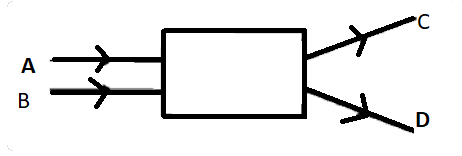
Light rays A and B fall on an optical component and come out as C and D. The optical component is a:

A) Prism
B) Concave Lens
C) Concave Mirror
D) Convex Lens
Answer
218.1k+ views
Hint: Here, in the diagram the two rays are diverging after going through the optical components. The diverging or converging of light rays depends on the angle of incidence of the light rays on to the lens or mirror and the type of lens and mirror is used.
Complete solution:
Here we need to evaluate each option carefully. Prism is a glass object which disperses and refracts light but it disperses light at a particular direction. In the given diagram the light is getting dispersed in two different directions. Concave mirror, whether concave or convex it reflects light and the image formed is behind the mirror so, as per the given diagram concave mirror is ruled out. Convex lens as the name indicates is converging in nature that means if any two parallel incident rays pass through the convex lens then the two rays will cross each other and here there is no such thing happening. Concave lens on the other hand is diverging in nature and if two parallel rays pass through the concave lens the lens will disperse the two rays in two different directions.
Option (B) is correct. Therefore, the optical component is a concave lens.
Note: Here, we need to see the nature of each lens or mirror and describe their function as to whether they diverge or converge the light rays passing through it. Mention the role of each lens and find out the lens or mirror that the diagram depicts.
Complete solution:
Here we need to evaluate each option carefully. Prism is a glass object which disperses and refracts light but it disperses light at a particular direction. In the given diagram the light is getting dispersed in two different directions. Concave mirror, whether concave or convex it reflects light and the image formed is behind the mirror so, as per the given diagram concave mirror is ruled out. Convex lens as the name indicates is converging in nature that means if any two parallel incident rays pass through the convex lens then the two rays will cross each other and here there is no such thing happening. Concave lens on the other hand is diverging in nature and if two parallel rays pass through the concave lens the lens will disperse the two rays in two different directions.
Option (B) is correct. Therefore, the optical component is a concave lens.
Note: Here, we need to see the nature of each lens or mirror and describe their function as to whether they diverge or converge the light rays passing through it. Mention the role of each lens and find out the lens or mirror that the diagram depicts.
Recently Updated Pages
Arithmetic, Geometric & Harmonic Progressions Explained

Cartesian Form of Vector Explained: Formula, Examples & Uses

Apparent Frequency Explained: Formula, Uses & Examples

Calorimetry: Definition, Principles & Calculations

Centrifugal Force Explained: Definition, Formula & Examples

Charge in a Magnetic Field: Definition, Formula & Examples

Trending doubts
JEE Main 2026: Application Form Open, Exam Dates, Syllabus, Eligibility & Question Papers

Derivation of Equation of Trajectory Explained for Students

Hybridisation in Chemistry – Concept, Types & Applications

Understanding the Angle of Deviation in a Prism

Understanding Collisions: Types and Examples for Students

How to Convert a Galvanometer into an Ammeter or Voltmeter

Other Pages
JEE Advanced Marks vs Ranks 2025: Understanding Category-wise Qualifying Marks and Previous Year Cut-offs

Understanding Atomic Structure for Beginners

Ideal and Non-Ideal Solutions Explained for Class 12 Chemistry

Degree of Dissociation: Meaning, Formula, Calculation & Uses

Understanding Electromagnetic Waves and Their Importance

Understanding the Electric Field of a Uniformly Charged Ring




